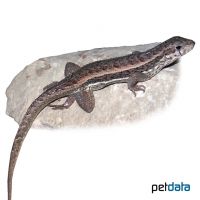Haitian Curlytail Lizard ♀ (Leiocephalus personatus)
| Haitian Curlytail Lizard ♀ Leiocephalus personatus | |
|---|---|
| Name | Haitian Curlytail Lizard ♀ |
| Name Lat. | Leiocephalus personatus |
| Family | Curly-tailed Lizards |
| Family lat. | Leiocephalidae |
| Order | Scaled Reptiles |
| Order lat. | Squamata |
| Origin | Hispaniola |
| Habitat | Light woods, beaches |
| Diet | Insects |
| Humidity | 60-70 % |
| Behavior | Peaceful |
| Keeping | Pair, harem |
| Care Level | Moderate |
| Reproduction | Oviparous |
| Housing | Semi-humid terrarium |
| Life Span | 5-10 years |
| Protection | No |
| Metric Units | |
| Size | 25 cm |
| Temperature | 25-28 °C |
| Temperature Local | 35 °C |
| Housing Size | 100 x 60 x 60 cm |
| US Units | |
| Size | 10" |
| Temperature | 77-82 °F |
| Temperature Local | 95 °F |
| Housing Size | 40" x 25" x 25" |
Distribution and habitat
The diurnal, ground-dwelling variegated masked iguanas are found exclusively on the Caribbean island of Hispaniola. There they inhabit dry areas, such as rock and scree landscapes, coastal dunes, scrubland and sparse forests. As crop followers, they can also be found in gardens and plantations.
Maintenance
Minimum dimensions for the terrarium, according to the size and number of animals:
| 1-2 animals | 6KRL x 4KRL x 4KRL (L x W x H) |
Head-torso length (KRL) is measured on the largest animal. For each additional animal, increase the footprint by 15%. A terrarium of e.g. L 100 x W 60 x H 60 cm is recommended, which should be placed in a quiet and vibration-free place
They need a spacious terrarium structured with roots, stone structures (hiding places and privacy screens) and resting places, a deep graveable substrate, e.g. of sand-loam mixture and rubble, partly covered with foliage, a shallow water dish and potted derb leafy plants. A small portion of the substrate should be kept moist at all times, for which Sphagnum moss, for example, is well suited. Once a day, preferably in the evening, the inside of the terrarium should be finely sprayed with water, but not directly the animals (risk of shock). A misting or rain system is ideal.
| Temp. day: 25-28 °C | Temp. night: 20-22 °C | Temp. local: up to 35 °C | Humidity: 60-70 |
Thermostatically controlled floor heating is recommended. Lighting duration must be 10-14 hrs depending on the season. They need a high light intensity. Special lamps that produce the necessary heat and UV light are ideal. Daily UV irradiation is essential.
Diet
The diet consists of live insects such as crickets, house crickets, grasshoppers, cockroaches, millipedes, spiders, zophobas and mealybug larvae, as well as sweet fruit, flower pollen and lettuce, which varies from individual to individual. Commercially available ready-to-eat foods for insectivorous reptiles are also often accepted. Wax moths should rarely be fed in very small amounts because of their large fat content. Young animals should be fed daily, adults 4-5 times a week. It is important to add minerals and vitamins regularly (dusting the feed). They have a great need to drink, accordingly drinking water must always be available
A varied diet promotes health and prevents deficiency symptoms.
Reproduction and breeding
Males have a white belly and a red and white spotted body, around the eye region a black "mask" and on the back and tail a comb about 2 mm high.
Several times a year (2-3 clutches) the female buries her eggs (3-8 pieces) in a suitable place in the soft, moist substrate. The incubation period is 60-70 days at a temperature of 28-30 °C. Small insects are suitable as initial food for the young.
Important
Adult males behave very territorial among themselves, but also among females there can be occasional incompatibilities. They can be kept well in a small group, 1 male with 2-3 females.
For the resting phase, shorten the lighting duration by 2-3 hours and lower the temperature by 3-4 °C for about two months.
The quality of the food animals can be upgraded by adding fruit and honey water as food.
The terrarium must have good ventilation without drafts and meet the species specific needs. Measuring devices such as thermometers, hygrometers, etc. are necessary. The lighting has to correspond to the species-specific day-night rhythm and has to be placed in such a way that the animals cannot injure themselves. The terrarium should be locked in such a way that neither unauthorized persons can open it nor the animals can escape. Contamination must be removed regularly
Further literature can be found in your pet store.
References
Text: petdata; Image: petdata
Source: BMELV (1997): Mindestanforderungen an die Haltung von Reptilien; ENGELMANN (2006): Zootierhaltung - Tiere in menschlicher Obhut: Reptilien und Amphibien, Verlag Harri Deutsch
- Gemäß § 21 Abs. 5 Tierschutzgesetz idgF
